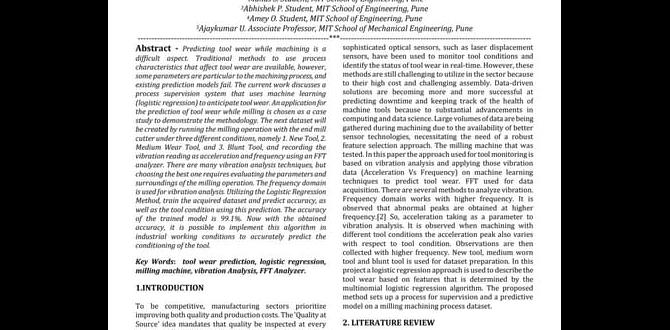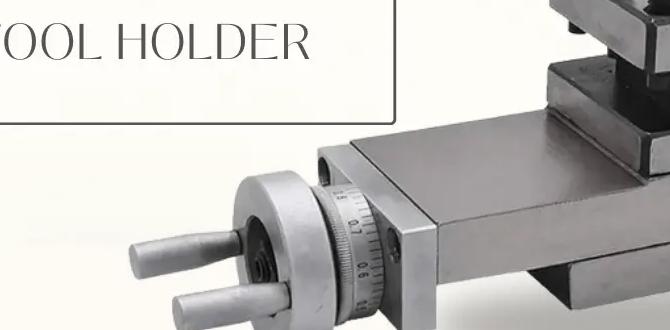Carbide end mills with a 10mm shank excel at chip evacuation, especially in tough materials. Choosing the right flute design, using appropriate cutting speeds and feeds, and employing coolant or air blasts are key to preventing chip recutting and ensuring smooth, efficient machining. Learn how to make your end mills work harder for you.
Ever found yourself staring at a workpiece, frustrated by chips jamming up your end mill? It’s a common headache for anyone getting started with milling, especially when tackling materials that love to cling. This can lead to poor surface finish, tool breakage, and a whole lot of rework. But what if I told you that your 10mm shank carbide end mill has secrets to shedding those troublesome chips more effectively? We’re going to dive into how you can harness the power of good chip evacuation to make your milling projects smoother, cleaner, and more successful. Get ready to turn those machining woes into victories!
The Heart of the Matter: Why Chip Evacuation is King
When you’re milling, you’re essentially shaving off small pieces of material. These pieces, called chips, need to go somewhere. If they don’t get out of the way quickly and efficiently, they can cause all sorts of problems. This is where “chip evacuation” comes into play. It’s all about how well your cutting tool and machining setup can clear those chips away from the cutting zone.
A 10mm shank carbide end mill, while standard for many tasks, presents specific challenges and opportunities for chip evacuation. The diameter of the shank itself can influence how much room there is for chips to escape, especially in smaller or deeper pockets. Carbide, being a hard and brittle material, is fantastic for holding an edge and cutting tough stuff, but it can also chip if chips get jammed and recut.
Common Chip Evacuation Nightmares (and why they happen)
- Chip Recutting: This is the big one. If chips aren’t cleared, the end mill comes back around and cuts through them again. This creates rough surfaces, loads up the flutes, and can quickly dull or break your tool.
- Workpiece Damage: Packed chips can act like an abrasive paste, marring your workpiece surface and leaving ugly marks.
- Overheating: Trapped chips don’t let coolant or air reach the cutting edge effectively, leading to increased heat which damages the tool and workpiece.
- Tool Breakage: The forces involved when chips can’t escape can be immense, leading to premature tool failure.
Understanding why these problems occur is the first step to fixing them. Fortunately, with a few key considerations, you can significantly improve chip evacuation with your standard tools.
Choosing the Right 10mm Shank Carbide End Mill for the Job
Not all carbide end mills are created equal, especially when it comes to clearing chips. The design of the flutes (the spiral grooves on the tool) is incredibly important. For general-purpose milling, you’ll often see end mills with 2, 3, or 4 flutes.
Flute Count Matters
- 2-Flute End Mills: These are generally the champions of chip evacuation. With fewer flutes, there’s more open space in the gumline (the area between the flutes) for chips to exit. They are excellent for softer materials and for plunging operations. However, they tend to chatter more and are not ideal for heavy-duty finishing.
- 3-Flute End Mills: A good compromise. They offer better chip carrying capacity than 4-flute mills and are more rigid, allowing for faster feed rates in many materials. They are often a great choice for general-purpose slotting and profiling.
- 4-Flute End Mills: These are the most rigid and provide the best surface finish in many common metals. However, they have the least amount of open space for chip evacuation. If you’re using a 4-flute end mill, especially in aluminum or stainless steel, you need to be extra mindful of chip clearing strategies.
For materials that produce long, stringy chips, like aluminum, or for materials that break into small, abrasive chips, like stainless steel, opt for fewer flutes whenever possible. A 2-flute end mill with a generous flute space is often your best bet for consistent chip evacuation in these situations.
Specialized Designs for Enhanced Evacuation
Beyond the flute count, manufacturers also offer specialized flute geometries to improve chip removal:
- High-Helix Flutes: These have a steeper spiral angle. What does this mean for you? A steeper helix helps to curl and eject chips more aggressively out of the cut. This is particularly beneficial in gummy materials.
- Chip Breaker or Chip Ejector Grinds: Some end mills have small notches or serrations ground into the cutting edge. These are designed to break long chips into smaller, more manageable pieces, making them easier to clear.
- Open Center/Chip Gullet Designs: While less common on standard 10mm shank end mills, some specialized tools might have a larger internal void to help facilitate chip flow away from the cutting edge once it’s exited the flute.
When selecting a tool, look at the manufacturer’s specifications. They will often indicate what the end mill is best suited for. For your keyword focus on “carbide end mill 10mm shank extra long for stainless steel 304 chip evacuation,” you’ll want to prioritize tools specifically designed for stainless steel and emphasizing “chip evacuation” in their description. This often means looking for 2 or 3 flutes and possibly a high-helix design.
Mastering Speeds and Feeds for Optimal Chip Shedding
This is where the magic happens! Speeds and feeds are not just about how fast you cut; they directly impact chip formation and evacuation. Getting this right is crucial. For beginners, this can seem daunting, but let’s break it down.
Understanding the Basics
- Spindle Speed (RPM): How fast the tool rotates.
- Feed Rate: How fast the tool moves through the material (e.g., inches per minute or millimeters per minute).
- Chip Load: This is the thickness of the chip that each cutting edge removes on each revolution. It’s a critical factor for good chip evacuation and tool life. A good chip load ensures you’re taking a proper chip, not rubbing or powdering the material.
Manufacturers provide recommended starting speeds and feeds for their tools, often based on the material being cut. You can find these charts on their websites or in their catalogs. A good starting point for a 10mm carbide end mill in stainless steel 304, for instance, might involve lower speeds and moderate feed rates, with a focus on achieving an adequate chip load. For example, a common starting point for a 10mm carbide end mill in 304 stainless steel might be around 40-70 SFM (Surface Feet per Minute) and a chip load of 0.0015-0.003 inches per tooth.
How Speeds and Feeds Affect Chip Evacuation
- Too High Spindle Speed / Too Low Feed Rate: This results in tiny, powdery chips or “rubbing.” These chips are hard to evacuate, can overheat the tool, and lead to poor surface finish. It’s like trying to sweep dust with a broom – it just scatters.
- Too Low Spindle Speed / Too High Feed Rate: This can lead to very large, heavy chips. While they might seem like “good” chips, if your flutes can’t clear them, they’ll jam up. This is where you risk tool breakage.
- Correct Chip Load: This is the sweet spot. When you achieve the recommended chip load (e.g., 0.002 inches per tooth for a 2-flute mill), you’re producing a chip that is thick enough to be easily formed and ejected by the flutes. These chips are typically well-formed and relatively easy for the tool to clear.
Pro Tip for Stainless Steel: Stainless steel, especially 304, is notorious for work hardening and producing gummy chips. You generally need to run carbide end mills at relatively lower surface speeds (SFM) compared to aluminum or mild steel, but maintain a good, consistent feed rate to ensure you’re taking effective chips. This is where a 10mm shank carbide end mill with good flute geometry really shines. Refer to resources like the Machinetoolhelp.com for tables that can help translate SFM to RPM for your specific machine and tool diameter.
Adjusting for Your Machine
Your machine’s rigidity and spindle power also play a role. A powerful, rigid machine can handle more aggressive cuts and better achieve the desired chip load. If your machine is less rigid, you might need to back off slightly on the feed rate and rely more on good tool selection and coolant.
Using a Tool Diameter vs. Shank Diameter Chart
While we’re focusing on the 10mm shank, remember that your end mill likely has a 10mm cutting diameter as well (or you might be using an adapter). The cutting diameter is what determines the necessary spindle speed for a given surface speed. A 10mm end mill needs to spin at a different RPM than a 5mm end mill to achieve the same surface speed.
Here’s a simplified example for calculating RPM:
RPM = (Surface Speed (SFM) 12) / (Tool Diameter (inches) π)
For a 10mm tool, you’ll first need to convert 10mm to inches (10mm ≈ 0.3937 inches).
Let’s say you want to achieve 50 SFM on 304 stainless steel with your 10mm end mill:
RPM = (50 12) / (0.3937 3.14159) ≈ 486 RPM
This is a very low RPM, and often when talking about carbide, higher RPMs are used with adjusted feed rates and excellent chip evacuation. Always consult manufacturer data and consider your specific application.
The Power of Coolant and Air Blast
Even with the best end mill design and speeds/feeds, chip evacuation can be significantly improved with auxiliary methods. Coolant and air blasts are your best friends here.
Coolant: More Than Just Cooling
When we think of coolant, we usually think of cooling the cutting edge. And yes, that’s vital. But coolant (or fluid) also plays a HUGE role in chip evacuation. The high pressure of the coolant jet can blast chips away from the cutting zone, preventing them from re-entering the cut and helping to flush them out of the flutes. Many modern milling machines and CNCs have High-Pressure Through-Spindle Coolant (TSC) systems specifically designed for this purpose, especially for difficult-to-machine materials like stainless steel 304.
Benefits of Coolant for Chip Evacuation:
- Flushing: Coolant actively pushes chips away from the tool and workpiece.
- Lubrication: Reduces friction, leading to cleaner cuts and less chip welding.
- Lower Cutting Temperatures: Prevents chip recutting due to heat softening.
For handheld CNC machines or manual mills without integrated coolant, you can use spray mists or flood coolant systems. Even a well-aimed squirt bottle of cutting fluid can make a difference for light cuts. For stainless steel, a good quality cutting fluid or synthetic coolant is highly recommended.
Air Blast: A Simpler Solution
If applying liquid coolant isn’t feasible or desirable, a directed air blast can be surprisingly effective, especially in materials that don’t produce extremely gummy chips. A nozzle directed at the cutting zone can blow chips away from the tool.
Considerations for Air Blast:
- Pressure is Key: A low-pressure air line might not be enough. You need sufficient force to dislodge and propel the chips.
- Chip Containment: Be aware that air blasts can fling chips around, so proper safety precautions (eye protection, enclosures) are even more critical.
- Less Effective for Gummy Materials: For materials that tend to stick, air alone might not be sufficient to overcome the adhesion.
Strategic Air/Coolant Nozzle Placement
The secret here is placement. Aim the coolant or air nozzle directly into the path of the chips as they are being generated. You want to give them a forceful nudge away from the workpiece and out of the flute.
Here’s a quick comparison:
Table 1: Coolant vs. Air Blast for Chip Evacuation
| Feature | Coolant (Flood/Mist/TSC) | Air Blast |
|---|---|---|
| Primary Action | Flushing, Lubrication, Cooling | Blowing Away |
| Effectiveness in Gummy Materials (e.g., Stainless Steel) | High | Moderate to Low |
| Chip Control | Excellent | Variable (can disperse chips widely) |
| Tool Cooling | Excellent | Moderate |
| Setup Complexity | Higher (systems required) | Lower (air line and nozzle) |
For optimal chip evacuation, especially when milling demanding materials like 304 stainless steel with a 10mm shank carbide end mill, a high-pressure coolant system is generally superior. However, a well-directed air blast can be a viable alternative in many situations.
Advanced Techniques for Extreme Chip Evacuation
Beyond the basics, several advanced strategies can push chip evacuation to the next level. These are particularly useful for deeper pockets, slots, or when working with sticky materials where standard methods might struggle.
Peck Drilling and Slotting
When milling deep pockets or slots, chips can easily get trapped at the bottom. Peck drilling (also known as chip breaking cycles in CNC programming) is a technique where the end mill plunges into the material a short distance, retracts slightly to clear chips, and then plunges again. This is repeated until the full depth is reached.
How it Works:
- Plunge into material to a programmed ‘peck depth’ (e.g., 1-2 times the tool diameter).
- Retract to a safe height (or to the surface if working with small chips).
- Repeat until target depth is achieved.
This intermittent plunging action ensures that chips are cleared at regular intervals, preventing buildup that could jam the tool. Most CNC controllers have specific G-code cycles (like G83 for peck drilling) to automate this process. For manual milling, you’ll do this step-by-step, manually retracting the Z-axis.
Ramping In and Out
Instead of plunging straight down, consider “ramping” into the material. This involves feeding the end mill downwards at an angle (e.g., 5-10 degrees) while simultaneously moving it in a helical path around the pocket perimeter. This creates a more gradual entry and allows chips to be evacuated along the ramp path rather than being plunged into the bottom.
Benefits of Ramping:
- Reduced cutting forces on entry.
- Improved chip evacuation compared to straight plunging.
- Less stress on the tool.
Many CAM (Computer-Aided Manufacturing) software packages offer ramping as a milling strategy. For manual operation, it requires careful control of three axes simultaneously.
Using a Different Tool for Pockets
Sometimes, the best chip evacuation strategy is to acknowledge tool limitations. If you’re milling a deep, narrow slot and your standard 10mm end mill is struggling to clear chips, consider if a specialized tool is warranted. Options might include:
- Slotting End Mills: These are designed specifically for cutting slots and often have a more robust design and better chip clearance.
- ZrN or TiCN Coated End Mills: Coatings can improve lubricity and reduce chip welding, indirectly aiding chip evacuation, especially in tough materials like stainless steel.
Workpiece Material Considerations
The type of material you’re cutting significantly impacts chip evacuation. As mentioned, 304 stainless steel is challenging. Other materials also present unique issues:
- Aluminum: Tends to produce long, stringy, “gummy” chips that readily stick to the tool. High-helix, 2-flute end mills, and ample coolant/air are crucial.
- Titanium: Known for its toughness and tendency to work harden. Requires slower speeds, robust tools, and excellent cooling to manage chip load without overheating.
- Plastics: Can melt and gum up flutes, requiring sharp tools, appropriate speeds, and sometimes specialized plastic-cutting end mills.
For your specific keyword, focusing on “304 stainless steel” means







